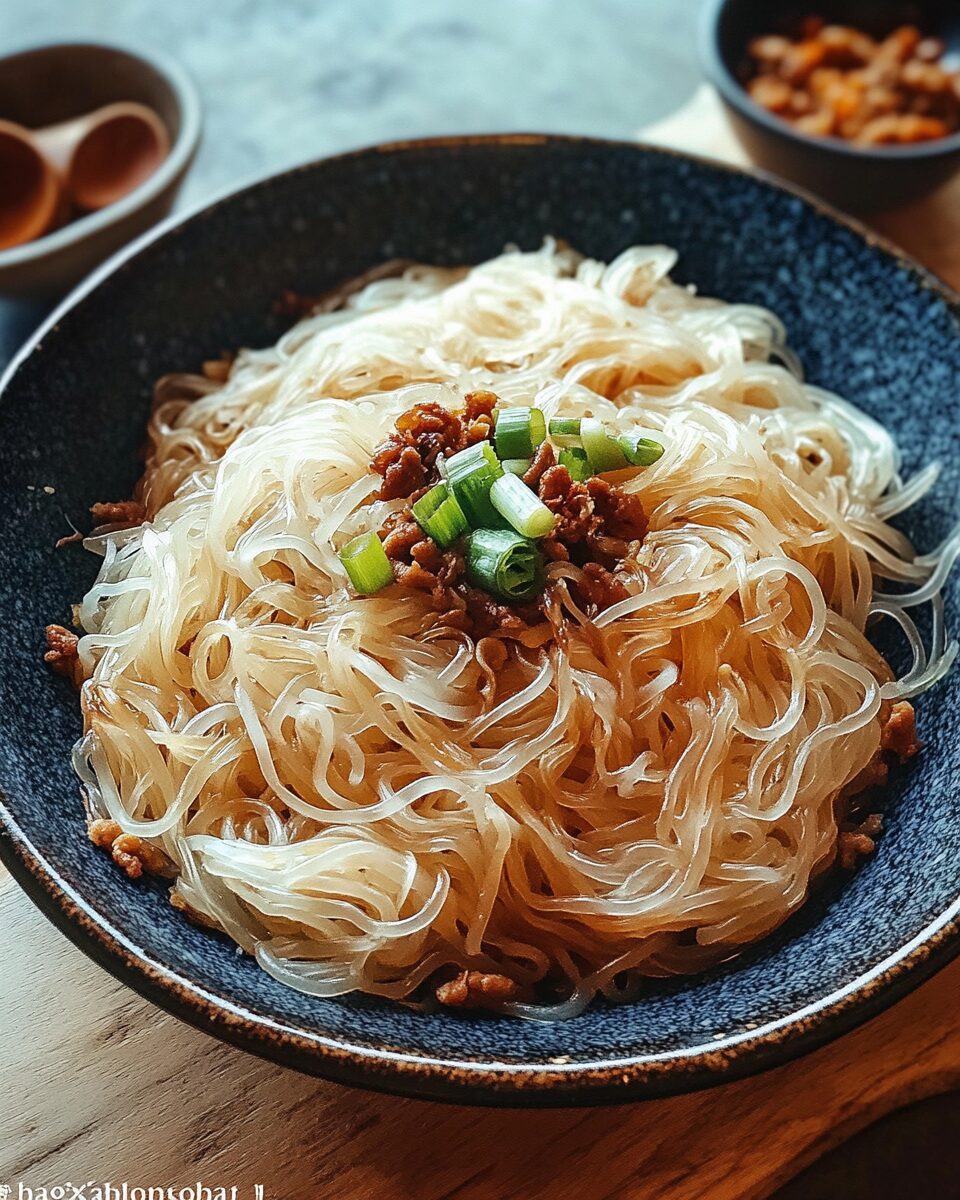This dish, with its poetic name and rich Sichuan roots, is a celebration of contrasts: silky vermicelli noodles soaking up bold flavors from chili bean paste, fragrant aromatics, and tender minced pork. Despite its dramatic name, there’s nothing intimidating about Ma Yi Shang Shu – it’s humble, homey, and deeply comforting.
Perfect for a cozy weeknight dinner or to impress with authentic Chinese flavors, this quick stir fry comes together in just 20 minutes. Serve it solo or over rice, and enjoy the addictive balance of spice, umami, and aroma that’s signature to Sichuan cuisine.
Full Recipe:
-
4 oz. (110 g) dried mung bean vermicelli noodles
-
1 tablespoon peanut oil (or vegetable oil)
-
1 tablespoon minced ginger
-
2 cloves garlic, minced
-
2 green onions, sliced
-
1 tablespoon doubanjiang (fermented chili bean paste)
-
4 oz. (120 g) ground pork
-
1/2 cup chicken broth (or water)
Sauce:
-
1 tablespoon light soy sauce
-
1 teaspoon dark soy sauce
-
1 tablespoon Shaoxing wine (or dry sherry)
-
1 teaspoon sugar
Directions:
-
Soak the mung bean vermicelli noodles in hot water for 15 minutes (or per package instructions). Once softened, drain and toss with 1/2 tablespoon oil. Set aside.
-
In a small bowl, mix all sauce ingredients and set aside.
-
Heat 1/2 tablespoon oil in a nonstick skillet over medium heat. Add the ginger, garlic, and green onions. Stir-fry for about 30 seconds until fragrant.
-
Add the ground pork and cook for 2 minutes, breaking it apart into small bits until fully cooked.
-
Stir in the doubanjiang and cook for another minute to coat the pork evenly.
-
Add the chicken broth, soaked vermicelli, and prepared sauce. Stir to combine, cover, and let steam for 2–3 minutes.
-
Uncover, stir, and continue cooking until the noodles are tender and the liquid is mostly evaporated, about 1–2 more minutes.
-
Serve hot as a flavorful main dish, optionally with steamed rice.
Prep Time: 10 minutes | Cooking Time: 10 minutes | Total Time: 20 minutes
Kcal: 273 kcal | Servings: 1 serving
The Story Behind Ma Yi Shang Shu (Ants Climbing a Tree)
Ma Yi Shang Shu (蚂蚁上树), or “Ants Climbing a Tree,” is one of Sichuan cuisine’s most whimsically named and beloved noodle dishes. The name paints a vivid picture — bits of minced pork (the “ants”) cling to long, transparent mung bean vermicelli (the “tree branches”), mimicking ants scurrying upward. Behind the poetic name lies a dish of deep umami, complex heat, and satisfying texture.
This dish is a classic example of Sichuan’s ability to transform humble ingredients into something greater than the sum of its parts. Despite its peculiar name, it remains a staple in many Chinese households and street stalls alike — celebrated for its speed, affordability, and full-bodied flavor. Its roots trace back to Sichuan province, a region in China famous for bold, spicy flavors and ingenious culinary techniques.
Why Ma Yi Shang Shu Is So Popular
Ma Yi Shang Shu holds a special place in Chinese cuisine because of its comfort-food qualities. It’s quick to cook, budget-friendly, and incredibly satisfying — ideal for busy home cooks. But more than that, it showcases the heart of Sichuan cuisine: balance. The salty umami of doubanjiang (fermented chili bean paste) is tempered by the mellow sweetness of mung bean noodles, while aromatics like ginger, garlic, and green onion add freshness and fragrance.
Its versatility also contributes to its popularity. The recipe can be tweaked to suit a range of dietary preferences and pantry constraints, making it a go-to meal for families and students alike. It’s equally suitable as a quick solo dinner or as part of a larger spread during family-style dining.
Understanding the Key Flavor Base
At the heart of Ma Yi Shang Shu lies a uniquely Sichuan flavor profile anchored by doubanjiang. This spicy, fermented paste made from broad beans and chili is often referred to as the “soul of Sichuan cooking.” It delivers deep umami and a subtle heat that distinguishes the dish from other noodle stir-fries across China.
The pork is typically ground finely so that it coats the noodles evenly — this is essential to creating the iconic “ants” look. Soy sauce adds saltiness and color, while Shaoxing wine brings a fragrant acidity that lifts the overall profile of the dish. A touch of sugar balances out the salty and spicy notes, rounding off the sauce beautifully.
Mung bean vermicelli, sometimes called cellophane noodles or bean thread noodles, are another essential component. These noodles are nearly flavorless on their own, but they are perfect carriers of sauce. Once rehydrated and simmered in the flavorful broth, they absorb all the savory, spicy nuances like a sponge.
Tips for Cooking Ma Yi Shang Shu at Home
Even though Ma Yi Shang Shu is a straightforward recipe, attention to technique makes a big difference. Here are some key tips to help you achieve the best version of this dish:
Use the Right Noodles: Mung bean vermicelli is the traditional noodle used in this dish. It turns translucent when cooked and has a slippery, chewy texture. Avoid substituting with rice vermicelli or wheat noodles, as they do not have the same ability to absorb flavor and may alter the texture dramatically.
Control the Heat: Since doubanjiang is quite salty and spicy, start with a smaller amount if you’re sensitive to heat. You can always adjust the amount based on your taste preference or use a milder version of the paste.
Don’t Overcook the Noodles: After soaking, the noodles will continue cooking as they simmer in the pan. Overcooking can turn them mushy and lead to clumping. Monitor closely during the final minutes and remove from heat as soon as the sauce is absorbed and the noodles are tender.
Nonstick Cookware is Key: Because mung bean noodles can be sticky, using a nonstick skillet is strongly recommended unless you’re comfortable working with a seasoned wok. It helps prevent the noodles from sticking or burning as the sauce reduces.
Variations to Explore
Though traditional Ma Yi Shang Shu sticks closely to a simple combination of noodles, pork, and sauce, it’s a dish that easily adapts to other flavors and ingredients. Here are a few common and creative variations you can try:
Vegetarian Version: Replace the ground pork with finely chopped shiitake mushrooms or crumbled tofu. Both ingredients provide a meaty texture and soak up the sauce just as well. Add more soy sauce or a splash of vegetarian oyster sauce to enhance umami.
Seafood Twist: Some cooks enjoy substituting pork with minced shrimp or a combination of shrimp and squid. These seafood options lighten the dish and add a subtle sweetness that contrasts well with the heat from the doubanjiang.
Green Boost: Add vegetables such as napa cabbage, julienned carrots, or spinach to the dish for extra color, nutrition, and crunch. Add them near the end of the cooking process so they remain crisp-tender.
Egg Addition: Scrambled eggs stirred in at the final stage can bring a velvety richness and more protein to the dish — a great choice for those cutting back on meat or cooking for kids.
Gluten-Free Adaptation: This dish can be made gluten-free by using tamari in place of regular soy sauce and dry sherry instead of Shaoxing wine. Be sure to double-check that the doubanjiang is gluten-free, as some brands contain wheat.
Serving Suggestions
Ma Yi Shang Shu can be served as a main dish or as part of a shared meal. While it stands perfectly on its own thanks to the combination of protein and carbs, it also pairs well with lighter sides. A cool cucumber salad or lightly steamed bok choy balances the heat and richness of the noodles.
For a heartier meal, serve it alongside bowls of jasmine rice or a simple broth-based soup. In many Chinese households, rice is often added to absorb any leftover sauce at the bottom of the plate — nothing goes to waste.
Drinks like lightly sweetened iced tea, chrysanthemum tea, or even a crisp lager are popular accompaniments to cut through the richness and spice of the dish.
Advertisement
Cultural Significance and Origins
While there’s no exact documentation of the origin of Ma Yi Shang Shu, it’s understood to be a part of everyday Sichuan home cooking, rather than a banquet or ceremonial dish. Its quirky name likely arose from an effort to make food more engaging for children or diners unfamiliar with Chinese cuisine. The practice of giving dishes colorful names is common across Chinese culinary traditions, from “Lion’s Head Meatballs” to “Beggar’s Chicken.”
Despite its humble origin, this dish has reached iconic status — not because it dazzles with fancy techniques or exotic ingredients, but because it delivers sheer comfort and satisfaction with every bite. It reflects the ingenuity of Sichuan cooking, where simplicity meets sophistication through smart layering of flavors.
Conclusion
Ma Yi Shang Shu is more than just a dish — it’s a conversation starter, a weeknight lifesaver, and a celebration of flavor. In just 20 minutes, it brings together everything we love about Sichuan cuisine: bold spices, aromatic depth, balanced textures, and imaginative presentation.
Whether you’re an experienced cook or a curious beginner, this recipe welcomes experimentation and rewards effort with unforgettable taste. Try it once, and it’s likely to become a staple in your kitchen, too. As with all great dishes, Ma Yi Shang Shu tells a story — one of tradition, family, and the joy of discovering something new with every twirl of your chopsticks.






